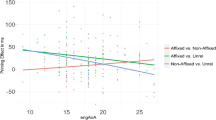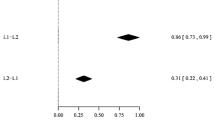Abstract
Greek-French bilinguals were tested in three masked priming experiments with Greek primes and French targets. Related primes were the translation equivalents of target words, morphologically related to targets, or phonologically related to targets. In Experiment 1, cognate translation equivalents (phonologically similar translations) showed facilitatory priming, relative to matched phonologically related primes, in conditions in which morphologically related primes showed no effect (50-msec prime exposure). Cross-language morphological priming emerged at longer prime exposure durations (66 msec), but cognate primes continued to generate more priming than did those in the morphological condition. In Experiments 2 and 3, the level of phonological overlap across translation equivalents was varied, and priming effects were measured against those for matched phonologically related primes and those in an unrelated prime condition. When measured against the unrelated baseline, cognate primes showed the typical advantage over noncognate primes. However, this cognate advantage disappeared when priming was measured against the phonologically related prime condition. The results are discussed in terms of how translation equivalents are represented in bilingual memory.
Similar content being viewed by others
References
Bowers, J. S., Mimouni, Z., &Arguin, M. (2000). Orthography plays a critical role in cognate priming: Evidence from French/English and Arabic/French cognates.Memory & Cognition,28, 1289–1296.
Brysbaert, M., Van Dyck, G., &Van de Poel, M. (1999). Visual word recognition in bilinguals: Evidence from masked phonological priming.Journal of Experimental Psychology: Human Perception & Performance,25, 137–148.
Bybee, J. L. (1985).Morphology: A study of the relation between meaning and form. Amsterdam: Benjamins.
Cristoffanini, P., Kirsner, K., &Milech, D. (1986). Bilingual lexical representation: The status of Spanish-English cognates.Quarterly Journal of Experimental Psychology,38A, 367–393.
De Groot, A. M. B. (1992). Bilingual lexical representation: A closer look at conceptual representations. In R. Frost & L. Katz (Eds.),Orthography, phonology, morphology, and meaning (pp. 389–412). Amsterdam: North-Holland.
De Groot, A. M. B., &Nas, G. L. J. (1991). Lexical representation of cognates and noncognates in compound bilinguals.Journal of Memory & Language,30, 90–123.
De Jong, N., Schreuder, R., &Baayen, R. H. (2003). Morphological resonance in the mental lexicon. In R. H. Baayen & R. Schreuder (Eds.),Morphological structure in language processing (pp. 65–88). Berlin: Mouton de Gruyter.
Diependaele, K., Sandra, D., &Grainger, J. (2005). Masked crossmodal morphological priming: Unravelling morpho-orthographic and morpho-semantic influences in early word recognition.Language & Cognitive Processes,20, 75–114.
Dijkstra, T., Grainger, J., &van Heuven, W. J. B. (1999). Recognition of cognates and interlingual homographs: The neglected role of phonology.Journal of Memory & Language,41, 496–518.
Drews, E., &Zwitserlood, P. (1995). Morphological and orthographic similarity in visual word recognition.Journal of Experimental Psychology: Human Perception & Performance,21, 1098–1116.
Finkbeiner, M., Forster, K., Nicol, J., &Nakamura, K. (2004). The role of polysemy in masked semantic and translation priming.Journal of Memory & Language,51, 1–22.
Forster, K. I., &Davis, C. (1984). Repetition priming and frequency attenuation in lexical access.Journal of Experimental Psychology: Learning, Memory, & Cognition,10, 680–698.
Forster, K. I., &Davis, C. (1991). The density constraint on formpriming in the naming task: Interference effects from a masked prime.Journal of Memory & Language,30, 1–25.
Forster, K. I., &Forster, J. C. (2003). DMDX: A Windows display program with millisecond accuracy.Behavioral Research Methods, Instruments, & Computers,35, 116–124.
Frost, R., Ahissar, M., Gotesman, R., &Tayeb, S. (2003). Are phonological effects fragile? The effect of luminance and exposure duration on form priming and phonological priming.Journal of Memory & Language,48, 346–378.
Frost, R., Forster, K., &Deutsch, A. (1997). What can we learn from the morphology of Hebrew? A masked priming investigation of morphological representation.Journal of Experimental Psychology: Learning, Memory, & Cognition,23, 1–28.
Giraudo, H., &Grainger, J. (2001). Priming complex words: Evidence for supralexical representation of morphology.Psychonomic Bulletin & Review,8, 127–131.
Gollan, T., Forster, K. I., &Frost, R. (1997). Translation priming with different scripts: Masked priming with cognates and noncognates in Hebrew-English bilinguals.Journal of Experimental Psychology: Learning, Memory, & Cognition,23, 1122–1139.
Grainger, J., Colé, P., &Segui, J. (1991). Masked morphological priming in visual word recognition.Journal of Memory & Language,30, 370–384.
Grainger, J., &Dijkstra, T. (1992). On the representation and use of language information in bilinguals. In R. J. Harris (Ed.),Cognitive processing in bilinguals (pp. 207–220). Amsterdam: North-Holland.
Grainger, J., &Frenck-Mestre, C. (1998). Masked priming by translation equivalents in proficient bilinguals.Language & Cognitive Processes,13, 601–623.
Grainger, J., &Jacobs, A. M. (1996). Orthographic processing in visual word recognition: A multiple read-out model.Psychological Review,103, 518–565.
Jacobs, A. M., Grainger, J., &Ferrand, L. (1995). The incremental priming technique: A method for determining within-condition priming effects.Perception & Psychophysics,57, 1101–1110.
Kim, J., &Davis, C. (2003). Task effects in masked cross-script translation and phonological priming.Journal of Memory & Language,49, 484–499.
Kirsner, K., Lalor, E., &Hird, K. (1993). The bilingual lexicon: Exercise, meaning and morphology. In R. Schreuder & B. Weltens (Eds.),The bilingual lexicon (pp. 215–248). Amsterdam: Benjamins.
Lalor, E., &Kirsner, K. (2001). The representation of “false cognates” in the bilingual lexicon.Psychonomic Bulletin & Review,8, 552–559.
Lemhöfer, K., &Dijkstra, T. (2004). Recognizing cognates and interlingual homographs: Effects of code similarity in language-specific and generalized lexical decision.Memory & Cognition,32, 533–550.
Lemhöfer, K., Dijkstra, T., &Michel, M. C. (2004). Three languages, one ECHO: Cognate effects in trilingual word recognition.Language & Cognitive Processes,19, 585–611.
Longtin, C.-M., Segui, J., &Hallé, P. A. (2003). Morphological priming without morphological relationship.Language & Cognitive Processes,18, 313–334.
New, B., Pallier, C., Ferrand, L., &Matos, R. (2001). Une base de donné es lexicales du français contemporain sur internet: LEXIQUE.L’Anné e Psychologique,101, 447–462.
Rastle, K., Davis, M. H., Marslen-Wilson, W. D., &Tyler, L. K. (2000). Morphological and semantic effects in visual word recognition: A time-course study.Language & Cognitive Processes,15, 507–537.
Rastle, K., Davis, M. H., &New, B. (2004). The broth in my brother’s brothel: Morpho-orthographic segmentation in visual word recognition.Psychonomic Bulletin & Review,11, 1090–1098.
Sánchez-Casas, R. M., Davis, C. W., &García-Albea, J. E. (1992). Bilingual lexical processing: Exploring the cognate/non-cognate distinction.European Journal of Cognitive Psychology,4, 293–310.
Sánchez-Casas, R. M., &García-Albea, J. E. (2005). The representation of cognate and noncognate words in bilingual memory: Can cognate status be characterized as a special kind of morphological relation? In J. F. Kroll & A. M. B. de Groot (Eds.),Handbook of bilingualism: Psycholinguistic approaches (pp. 226–250). Oxford: Oxford University Press.
Taft, M., &Forster, K. I. (1975). Lexical storage and retrieval of prefixed words.Journal of Verbal Learning & Verbal Behavior,14, 638–647.
Van Heuven, W. J. B., Dijkstra, T., &Grainger, J. (1998). Orthographic neighborhood effects in bilingual word recognition.Journal of Memory & Language,39, 458–483.
Van Heuven, W. J. B., Dijkstra, T., Grainger, J., &Schriefers, H. (2001). Shared neighborhood effects in masked orthographic priming.Psychonomic Bulletin & Review,8, 96–101.
Williams, J. N. (1994). The relationship between word meanings in the first and second language: Evidence for a common, but restricted, semantic code.European Journal of Cognitive Psychology,6, 195–220.
Author information
Authors and Affiliations
Corresponding author
Rights and permissions
About this article
Cite this article
Voga, M., Grainger, J. Cognate status and cross-script translation priming. Memory & Cognition 35, 938–952 (2007). https://doi.org/10.3758/BF03193467
Received:
Accepted:
Published:
Issue Date:
DOI: https://doi.org/10.3758/BF03193467




